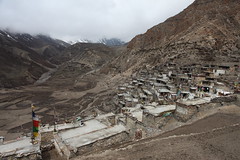Close encounters of the feline kind. Some readers may find some of the photos in this blog distressing.
On Wednesday 19th we left Thame for Namche Bazaar. After a stopover there to refuel on chocolate cake and apple pie in the heavenly Namche Bakery, we set out the next day for our new destinations. Khunde and Khumjung are 330m/1,000ft m above Namche Bazzar at around 3,730m/12,300ft. We’d heard that there’d been some recent livestock losses there so we were keen to check them out.

On the way up to these villages is a yak farm run by the Government of Nepal. Only 10 days or so before our visit they had lost a young female yak. Whether snow or forest leopard they couldn’t say, but it was killed quite close to the enclosure where the animals spend each night. What’s more, it was preyed upon during the day, not the usual dusk, dawn or nocturnal periods. While this was the only yak that the farm had lost in the last 12 months, the deaths of another three animals in the immediate area had also been attributed to leopards. We took a picture of what was left of the deceased yak, interviewed the manager of the farm, and headed on up the hill.
As we crested the ridge, Niki took a photo of some blood pheasants, yet another beautiful member of this unique Himalayan ecosystem. The environment here exists, of course, on a physical level. Like with every other part of planet earth it provides water, food, shelter, etc. that we need to survive; our dependence on it is complete. But nature also exists on another important level, too.
It exists in parallel in the mind. Take the snow leopard for example. Very few people ever see it, even those who live their entire lives in these mountains. The most that the majority ever experience of it is a pugmark in the snow, or the carcass of a dead animal, wild or domestic. Yet it looms large in the individual mind and the collective psyche.

The snow leopard is the ghost of the mountains. It is perceived to be a deity, a harbinger of supernatural wrath. Local people burn incense to appease it and speak of it with respect, if not always with affection. In Khunde we photographed a lovely drawing of the village by a 13 year old boy called Phurba Namgyal Sherpa. There was the snow leopard in his work of art (top left, chasing the yaks). Phurba may never see a live snow leopard but it is as real to him as the livestock in front of his house. It roams free in the hills above his home, but it also lives in his imagination, his worldview and his culture.
The same can be said of the yeti as well, but its existence in the mind’s eye is not matched by physical reality. That’s not what the local monastery in Khumjung would have us believe though. Unfortunately, when we called to see its ‘yeti’ skull, the building was closed.

We did manage, however, to make a visit to another village character. Two weeks previously, a young cow had been grabbed by the throat by a leopard in the undergrowth at the edge of Khumjung. Somehow it had managed to break free of its attacker and had spent the time since convalescing in its owner’s barn. We stopped by to exchange pleasantries, trampled through its dung and took a few snaps. Then we left this unassuming celebrity to itself, desiring our own close encounter of the feline kind, if not quite like that.







Reblogged this on Dr Jonny Hanson and commented:
In Snow Leopard Fieldwork Diaries 6, Jonny et al come face-to-face with the realities – and mythologies – of living alongside large carnivores.
Lock up your yaks.